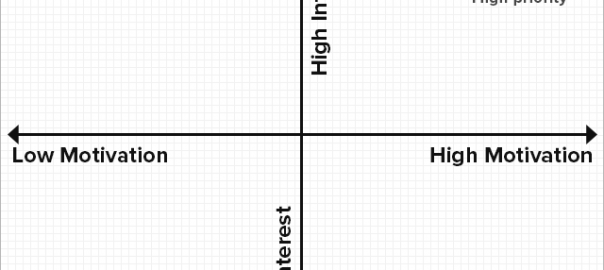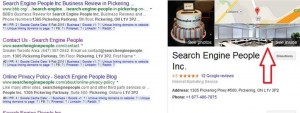— November 14, 2018
Streamlining your agency pipeline will help you close more deals and find better clients. This article shares three critical tips to unclog your agency pipeline.
Running an agency is a matter of balance. You have to execute existing projects, while also making sure that you have new deals coming through.
But far too often, agencies focus so much on current projects that they completely forget about their pipeline. They don’t actively prospect for new clients, nor do they have a way to capture and qualify leads consistently.
At a time when agency-client engagements are becoming increasingly project-based, this is a recipe for disaster. Once your existing projects dry up, do you have a system to land new clients?
This is why it is crucial to think about your pipeline. A streamlined pipeline will ensure that you have a steady supply of leads coming through. It also help you chase the right kind of clients, not just the first prospect who knocks on your door.
This guide will show you how to streamline your agency pipeline.

Understand the Opportunity Timeline
The conventional B2B sales process is predicated largely on need. An insurance company needs paper, so it calls up a handful of vendors for quotes. The vendor that best fulfills its needs gets the contract.
The agency sales cycle is different. For one, agencies aren’t just “vendors”; they’re “partners”. A good agency partner is often deeply involved in its client’s business. You can’t displace it simply by promising better results or lower prices.
Thus, the agency sales cycle is based less on need and more on opportunity. The entire process is largely consultative in nature. To get in, you have to be in the right place at the right time.
This is why it is crucial to understand the prospect opportunity timeline. This timeline defines where your clients are in their existing agency relationships. What kind of sales approach you’ll use will depend on the present context of your prospects.
By and large, your prospects will fall into one of the following five buckets:
1. They already have an agency
Most of your target clients will already have an agency (or agencies) of record. Unless things go horribly wrong, they’re unlikely to switch before the end of the contract.
Your sales approach with such clients has to be opportunity-focused. You can’t “brute force” your way into their accounts. Rather, you have to wait for an existing contract to run out, or for the client to review their agency performance (typically at the end of a contract or a reporting quarter/year).
In the meantime, focus on establishing top-of-mind awareness.
2. They’ve already committed their budgets
This second category includes clients who’ve already committed their budget for the current cycle. They’re focused on executing existing plans than looking for new agencies. You’re unlikely to get an in, at least not until the end of the current budgeting cycle.
With such clients, your goal should be to understand the rhythms of their business. When do they establish budgets? Do they review budgets mid-cycle? What is the timeline of their current plan?
Focus on establishing a relationship with these clients. When their current commitments end, you should be ready with a pitch.
3. They’re expanding their operations
A client that just received funding, launched a project, or acquired a new client is likely in expansion mode. This is the time when they’ll often review their current agency accounts, find gaps, and shop around for better results.
A client expanding its operations makes for a great prospect, especially if the expansion is in an area their current agency is not adept at. Look out for funding news, mergers/acquisitions, new launches, new hires, etc., and jump in with a pitch.
4. They’ve got new decision makers
If your target client has a new decision maker, consider it a positive sign. One of the first thing new decision makers do is to review existing relationships. Should their current agency performance not be up to scratch, it leaves the door open for new entrants.
Keep an eye out on personnel moves in your target industry. If you see marketing decision makers moving to new companies, reach out and let them know that you’re around.
5. They don’t have a specialized agency
It’s rare to find an established business that doesn’t have an agency. But businesses without specialized agencies are a dime-a-dozen.
This represents your most promising segment. Maybe your target client has a social media agency but lacks an SEO presence. Or maybe they have a branding agency but no way to create content. Clients increasingly look for domain expertise instead of a generic “full-service” agency experience.
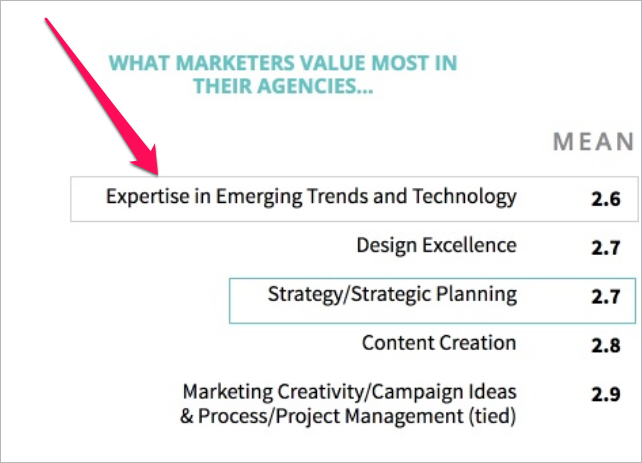
Image source: SoDAReport
If you can offer these prospects specialized services, they’ll often be ready to hire you alongside (or in place of) their current agency. Pursue these opportunities aggressively.

Adopt Separate Short and Long-Term Sales Strategies
Should you chase prestigious clients that may not close, or should you chase those “guaranteed” low-value leads already in your pipeline?
This is a perpetual dilemma for agencies. The clients you want to work with – high-value, prestigious brands – are rarely in the market. You have to massage them for months, even years before you get a bite.
At the same time, you likely have dozens of qualified but low-value leads coming in every month. Closing these leads is much easier, but the payoff – both in dollar terms and agency reputation – is low.
Focus too much on these short-term opportunities and you can miss high-value deals. Chase the latter and you might find that you don’t have any clients.
The solution to this ‘balance’ problem is to develop a two-stage strategy. This strategy should focus on cash flow through immediate opportunities while keeping one eye on your target brands.

I’ll show you how to implement this below.
Grab Short-Term Opportunities
With a short-term approach, your goal is to find clients who need your agency right now. These aren’t necessarily your “ideal” clients, but they have an immediate need and give your agency that vital cash flow and experience.
To grab these opportunities, your sales approach should be broad and shallow. Your goal should be to identify as many prospects as possible and reach out to them.
Don’t fret about extensive personalization or the right fit. Instead, you need to be visible, available, and check the client’s requirements.
What do clients who have an immediate need look for?
According to one survey, their top criteria includes expertise, results, and experience.
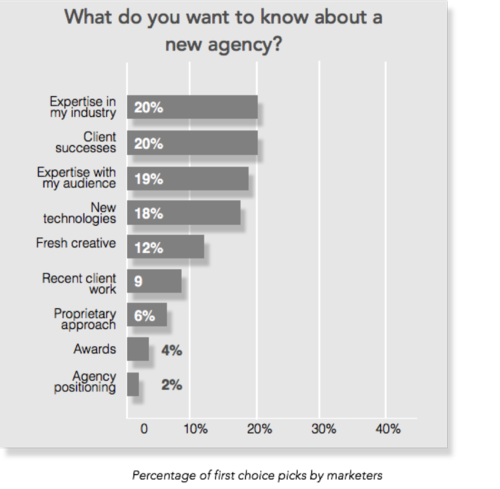
This makes sense – a client who needs something right now is mostly concerned about proven results.
Your pitch, therefore, should highlight the same. Don’t focus on your “culture” or “creative DNA”. Rather, emphasize your ability to deliver results. Share case studies, offer free consultation calls, and showcase your expertise.
Since these prospects have an immediate need, they’re often actively searching the market. Your best bet is to maintain high visibility on popular industry platforms, agency directories, and industry blogs. A strong presence will usually lead to prospects reaching out to you directly.
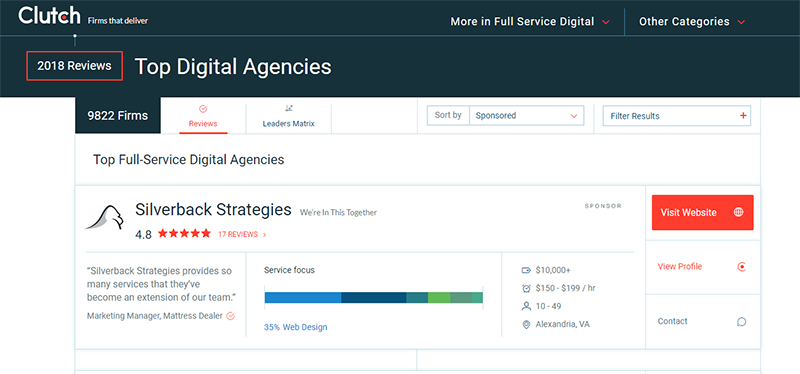
Clients often turn to platforms like Clutch to find agencies. These are usually highly motivated buyers looking to fulfill a pressing need.
Don’t Forget Long-Term Opportunities
Every agency founder has at least one “dream client” he’s wanted from the day he founded the agency.
But in the pursuit of cash flow and short-term opportunities, it’s easy to forget these dream clients. You have bills to pay and clients to service; you can’t really devote resources to pursuing a reluctant opportunity for months.
The solution to this problem is to attune your outreach to the requirements and rhythms of your target clients. Marketers are increasingly being tied to P&L performance. If you can figure out when your clients review their agency performance, renew their budgets, or report their profits, you can eke out a window to pitch your services.
In your long-term strategy, start by making a list of a handful of target clients. These should be brands you really want to work with.
Next, research these clients thoroughly. Dig through trade publications, ask colleagues, and immerse yourself in the industry to figure out:
- What kind of relationship they have with their current agencies?
- When do they report their performance or review agency accounts?
- What future need do they have (say, a new launch), and if it is being fulfilled by their current agency?
Your goal is to understand how these target clients operate. You should know both their needs and wants. The better you understand them, the better your pitch.
While you’re doing your research, reach out to these clients in a non-salesy way. Share ideas and valuable content. Don’t try to sell anything; just focus on building a relationship.
Research shows that 71% of B2B buyers are happy to receive valuable content very early in the sales process.
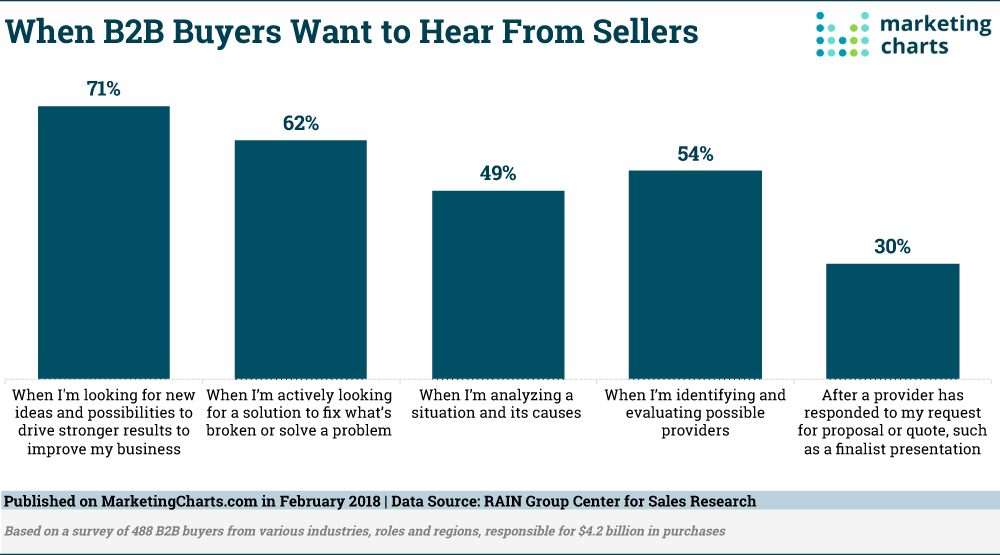
This way, you maintain top-of-mind-awareness. When the opportunity does present itself, you’ll have a stronger case for yourself.
Ideally, you should divide your time equally between short and long-term opportunities. Short-term opportunities will be your bread and butter, but long-term clients will make your agency’s brand and the bulk of its revenues.

Streamline Your Marketing Content Creation
Marketing in 2018 means creating content.
I don’t have to tell you that, of course. You already know that if you’re going to attract leads and interest, you’ll have to create content.
The problem starts when you try to figure out what kind of content to create, where to publish it, and how to streamline it. Should you focus on more thought pieces? Or should you publish more late-stage content like case studies?
While the safe answer would be to “strike a balance”, you’ll get far better mileage by producing content your clients actually want.
To do this, you have to first figure out how clients actually find their agency partners.
Map How Clients Find Agencies
If you’re going to “be where your customers are”, you have to understand your clients’ procurement process. How do they go about their agency search? What sparks their “discovery”? And who all are involved in decision making?
The answers to these questions will depend on the kind of clients you’re working with. Large businesses usually have dedicated procurement departments. For a small business, this “department” might just be the CMO Googling things on his lunch break.
So first step: figure out your target client persona. Your marketing approach for Fortune 500 clients will be drastically different from your approach for 10-person startups.
Identify your ideal client and map their:
- Company size
- Decision-making hierarchy
- Initial discovery process
- Whether they work primarily with local, regional, or international firms
- Whether they’re looking for a principal agency or a “tactical” agency for project-based work
The last point is particularly important. Principal agencies are all about fit, while project-based work is mostly about results and capabilities.
The best source of this information is your current set of clients. Get 15 minutes of their time and interview them about their procurement process. Ask:
- What was the internal need that sparked the agency search?
- Do they have a defined procurement process?
- Where all did they look for an agency partner?
- What did they look for in their agency partner? Which of your qualities helped you land the deal?
- How important was the problem (that they hired you to solve) to them?
Your goal should be to map each of the steps your clients took in their agency search. The more you understand the platforms, practices, and processes they used, the better you can serve their needs.
Categorize Your Clients
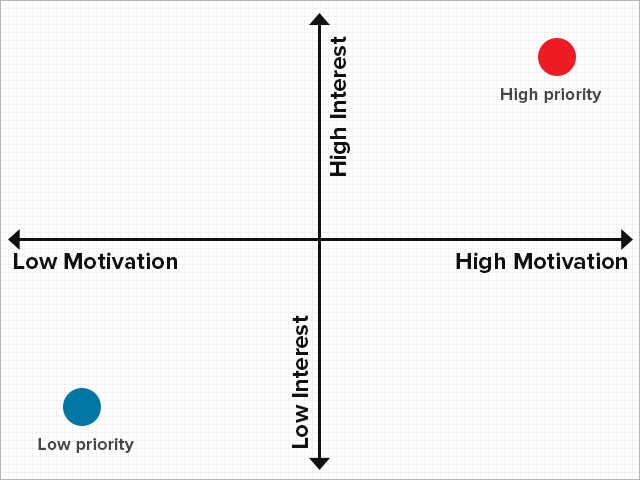
The two things that impact how clients approach the sales process are motivation and interest.
Motivation is a measure of a client’s willingness to close a deal. A highly motivated buyer usually has an urgent need.
Interest measures your client’s interest in solving his problems. An interested buyer understands that he has an issue and wants help to solve it.
When you map your clients’ procurement processes, it will also give you insight into how motivated and interested they are in forging an agency partnership.
For instance, a highly motivated and interested client will start his search on agency search platforms like Clutch. A buyer like this is much easier to close than someone who is neither motivated nor interested in your services.
Look for signs of interest or motivation such as strong industry knowledge, targeted search queries, and use of platforms or queries that focus on solving an immediate need. Someone searching for “PHP developers”, for example, has more focused requirement than someone looking for “branding” help.
Based on your clients’ procurement processes, categorize your clients as follows:
- High interest, high motivation
- High interest, low motivation
- Low interest, high motivation
- Low interest, low motivation
As you can imagine, category #1 clients should be your top priority, while those in category #4 are better targeted over time with educational content.
Balance Brand and Sales Content Creation
Your content can be divided into two broad categories:
- Sales-focused, i.e. content that answers “what” questions about your agency – what are your capabilities, results, and process. Examples include case studies, eBooks, white papers, how-to’s, etc. Sales-focused content is meant to inform, capture, or convert visitors and leads.
- Brand-focused, i.e. content that answers “who” questions about your agency – who you are, who you work with, your beliefs, etc. Think of thought pieces, interactive websites, etc. Brand-focused content has one goal – to promote your agency brand.
What kind of content you’ll prioritize will depend on:
- How motivated and interested your clients are
- Whether you’re offering tactical solutions or aiming to be the principal agency
Highly motivated clients looking for tactical solutions need targeted sales-focused content. They want to know your capabilities and what kind of results you can get. If most of your clients fall in this bucket, create more case studies, white papers, and how-to content.

WebPageFX creates a lot of marketing guides to cater to its largely small business audience that needs immediate marketing help
On the flip side, clients early in the discovery phase looking to replace their principal agency want to know who you are and what you believe in, hence, more brand-focused content. Share more about yourself with thought pieces and creative projects.
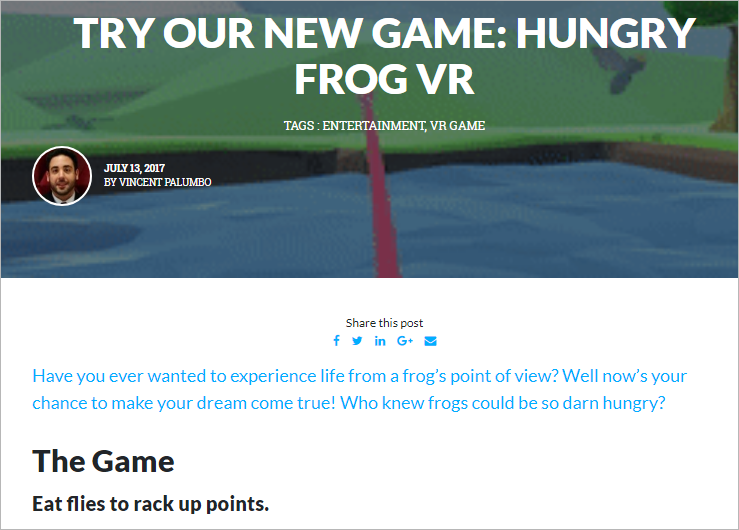
York and Chapel created a VR game to showcase their technical capabilities while also branding themselves as an innovative and fun agency.
Over to You
Keeping your pipeline topped with high-quality leads while also serving existing clients can be a tough balancing act. It’s easy to miss out on high-value deals as you pursue easier, short-term opportunities.
Streamlining your sales approach can help you divide your attention better. Use these three tips as a starting point in this exercise.
For even better insight into your sales pipeline, switch to a PM tool such as Workamajig that combines your project and sales data into a single dashboard.
Business & Finance Articles on Business 2 Community
(43)
